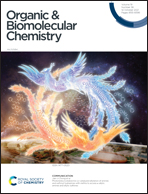An HDAC8-selective fluorescent probe for imaging in living tumor cell lines and tissue slices†
Abstract
Histone deacetylase 8 (HDAC8) has been used as a therapeutic target for many cancers as it is highly expressed in neuroblastoma cells and breast cancer cells. HDAC8-selective fluorescent probes need to be urgently developed. Herein, two novel fluorescent probes, namely NP-C6-PCI and AM-C6-PCI, based on the conjugation of 1,8-naphthalimide with a highly selective inhibitor of HDAC8 (PCI-34051) were reported. Compared with PCI-34051 (KD = 6.25 × 10−5 M), NP-C6-PCI (KD = 8.05 × 10−6 M) and AM-C6-PCI (KD = 7.42 × 10−6 M) showed great selectivity toward HDAC8. Two fluorescent probes exhibited high fluorescence intensity under λex = 450 nm and a large Stokes shift (100 nm). NP-C6-PCI was selected for cell and tissue imaging due to the similarity in the bioactivity of NP-C6-PCI with PCI-34051. The ability of NP-C6-PCI to target imaging HDAC8 in SH-SY5Y and MDA-MB-231 tumor cells was demonstrated. Furthermore, NP-C6-PCI was applied to imaging SH-SY5Y tumor tissue slices to indicate the relative expression level of HDAC8. Therefore, this HDAC8-selective fluorescent probe can be expected for applications in HDAC8-targeted drug screening as well as in pathologic diagnoses.

- This article is part of the themed collection: Chemical Biology in OBC


 Please wait while we load your content...
Please wait while we load your content...